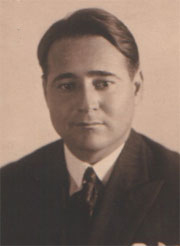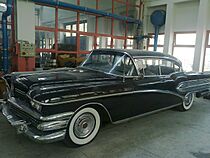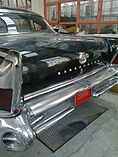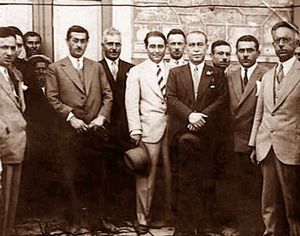Adnan Menderes facts for kids
Quick facts for kids
Adnan Menderes
|
|
|---|---|
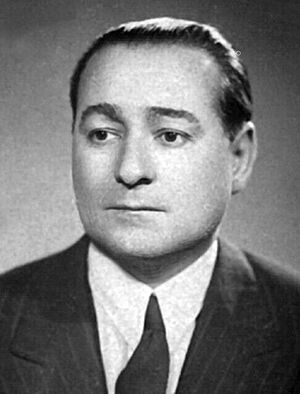
Menderes in 1939
|
|
| 9th Prime Minister of Turkey | |
| In office 22 May 1950 – 27 May 1960 |
|
| President | Celal Bayar |
| Preceded by | Şemsettin Günaltay |
| Succeeded by | Cemal Gürsel |
| Leader of the Democrat Party | |
| In office 9 June 1950 – 27 May 1960 |
|
| Preceded by | Celal Bayar |
| Succeeded by | Position abolished |
| Member of the Grand National Assembly | |
| In office 25 April 1931 – 27 May 1960 |
|
| Constituency | Aydın (1931, 1935, 1939, 1943) Kütahya (1946) Istanbul (1950, 1954, 1957) |
| Personal details | |
| Born | 1899 Koçarlı, Aydın Vilayet, Ottoman Empire |
| Died | 17 September 1961 (aged 62) İmralı Prison, İmralı, Turkey |
| Cause of death | Execution by hanging |
| Political party | SCF (1930) CHP (1930–45) DP (1946–60) |
| Spouse |
Berrin Menderes
(m. 1928) |
| Children | Yüksel, Mutlu, Aydın |
| Alma mater | Ankara University, Law School |
| Signature |  |
Adnan Menderes (1899 – 17 September 1961) was an important Turkish politician. He served as the Prime Minister of Turkey from 1950 to 1960. He was one of the people who started the Democrat Party (DP) in 1946. This party was the fourth legal opposition party in Turkey's history. After a military takeover in 1960, he was put on trial and sadly, he was executed along with two other government ministers.
Menderes was the last Turkish political leader to be executed after a military coup. He is also one of only four leaders of the Turkish Republic to have a special memorial (a mausoleum) built in his honor.
Contents
Early Life and Political Start
Adnan Menderes was born in 1899 in Koçarlı, a town in Aydın Province. His family were wealthy landowners. He went to the American College in İzmir for primary school. During the Turkish War of Independence, he fought against the Greek army and received a medal for his bravery. He later studied law at Ankara University.
In 1930, Menderes helped create a local branch of the Liberal Republican Party in Aydın. After this party closed down, Atatürk himself invited Menderes to join the main ruling party, the Republican People's Party. In 1931, he became a "deputy" (like a member of parliament) for Aydın. In 1945, he was asked to leave the party because he disagreed with some of its policies.
Rise to Power
In June 1945, Menderes and three friends (Celâl Bayar, Fuat Köprülü, and Refik Koraltan) asked for more political freedom in Turkey. This request was called the "Motion with four signatures." However, no other members of parliament supported it. By September 1945, Menderes and his friends were removed from the CHP because of their opposition to the government.
On January 7, 1946, these four politicians formed the Democratic Party (DP). In the 1946 elections, Menderes became a deputy for Kütahya. In the first truly free elections in Turkey on May 14, 1950, the Democratic Party won a lot of votes (52%). This meant Menderes became the Prime Minister. In 1955, he also took on the role of foreign minister. His party won two more elections, in 1954 and 1957.
During his 10 years as Prime Minister, Turkey's economy grew quickly. He wanted Turkey to be allies with Western countries. In 1952, Turkey joined NATO, a military alliance. With financial help from the United States through the Marshall Plan, farming became more modern. Transportation, energy, education, and healthcare also improved a lot.
However, some people say that Turkey faced an economic crisis in the mid-1950s during Menderes's time. This crisis might have been one reason for some difficult events that happened, like the Istanbul pogrom.
Istanbul Events of 1955
In 1955, there were serious events in Istanbul that affected the city's Greek minority. In September 1955, a bomb exploded near the Turkish consulate in Thessaloniki, Greece. It also damaged the Atatürk Museum, which was Atatürk's birthplace. The damage to the museum was small, mostly broken windows.
After this news, thousands of shops, houses, churches, and even graves belonging to the Greek community in Istanbul were destroyed within a few hours. Many people were hurt, and some lost their lives.
At the time, Turkey and Greece were discussing the future of Cyprus. The United Kingdom had invited both countries to a meeting in London. The day before the meeting, Menderes claimed that Greek Cypriots were planning to harm Turkish Cypriots.
The Menderes government was also dealing with economic problems in Turkey. Some believe that focusing on the Cyprus issue and the Greek minority in Istanbul was a way to distract people from the economic difficulties. The Greek population, though a minority, played a big role in Istanbul's businesses. This made them an easy target during the economic crisis.
Later, during the Yassıada trials after the 1960 military takeover, Menderes and his foreign minister were accused of planning these events. The court found that the bombing in Thessaloniki was a setup organized by the Menderes government. They were accused of planting the bomb and bringing angry villagers from Anatolia to Istanbul to cause trouble. Menderes later apologized and offered money to those who were affected.
Surviving a Plane Crash
On February 17, 1959, Prime Minister Menderes was on a Turkish Airlines plane flying from Istanbul to London Gatwick Airport. The plane crashed a few miles before the runway in heavy fog. Nine passengers and five crew members died.
Menderes, who was sitting in the back of the plane, survived with almost no injuries. A local resident, Margaret Bailey, gave him first aid. He was then taken to a hospital in London.
He was traveling to London to sign important agreements about the Cyprus issue with the British and Greek Prime Ministers. These agreements gave the three countries the right to step in if peace was broken in Cyprus. Menderes signed the London Agreement from his hospital bed on February 19, 1959. When he returned to Turkey on February 26, he was welcomed by a huge crowd, including his political rival, İsmet İnönü.
Political Style and Beliefs
Menderes was known for giving away or selling much of his inherited land to many small landowners. He was more accepting of traditional ways of life and different practices of Islam than earlier leaders. For example, he campaigned to make the Arabic call to prayer (adhan) legal again, which had been banned. He also opened thousands of mosques across the country. Some critics said he used religion for political gain.
One of his first actions was to replace pictures of İsmet İnönü on Turkish money and stamps with pictures of Atatürk. This was a popular move because Atatürk was highly respected.
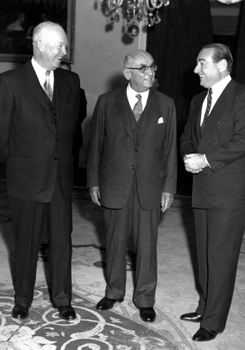
While he kept Turkey allied with Western countries, he also worked to build stronger relationships with Muslim nations. Menderes had a more open economic policy than previous prime ministers, allowing more private businesses. His policies, especially spending on agriculture and infrastructure, were popular with farmers in Turkey.
However, he did not like criticism. He introduced censorship for the press and had journalists arrested. He also tried to control opposing political parties and institutions like universities. Although he was popular with many people, he became less popular among intellectuals, university students, and some young military officers. They worried that the ideas of Atatürk (Kemalism) were in danger.
A key event that led to his downfall was the creation of the "Commission of Inquiries." This commission was made up only of members from Menderes's own party. It was given the power to act as both prosecutors and judges, which went against the idea of separation of powers. The commission's decisions could not be appealed.
Military Takeover and Its Aftermath
On May 27, 1960, a military takeover happened. It was organized by 37 young military officers. The government was removed, and Menderes was arrested along with President Bayar and other important party members. They were accused of breaking the constitution, misusing state money, and ordering the events in Istanbul that affected the Greek community.
Menderes and other leaders of his party were put on trial by a military court on the island of Yassıada (these were called the Yassıada trials). Menderes, Bayar, and two former government ministers were sentenced to death. Many world leaders, including John F. Kennedy and Queen Elizabeth II, asked for them to be pardoned. However, Menderes was executed on the island of İmralı on September 17, 1961. The former President Bayar's sentence was changed to imprisonment instead.
Two months later, a new government was formed. The Justice Party, which continued Menderes's legacy, later won many elections, especially under the leadership of Süleyman Demirel.
Legacy
On September 17, 1990, 29 years after his execution, the Turkish Parliament officially pardoned Adnan Menderes. His grave was moved to a mausoleum named after him in Istanbul. Fatin Rüştü Zorlu and Hasan Polatkan, the foreign affairs and finance ministers who were executed with Menderes, were also cleared of any wrongdoing.
Many places are named after him, including Adnan Menderes University in Aydın and Adnan Menderes Airport in İzmir. There are also high schools, city districts, boulevards, and streets across Turkey named in his honor.
In 2006, a top lawyer in Istanbul suggested that calls to stop Menderes's execution were made, but the military government cut off the phone lines. In March 2023, a monument to Adnan Menderes was unveiled at a university in Turkestan.
Film and Television
- The last part of Menderes's life, from his plane crash survival to his execution, was shown in the TV series Hatırla Sevgili (meaning "English: Remember Darling").
- The time when Menderes was prime minister (1950-1960) was shown in the TV series Ben Onu Çok Sevdim (meaning "English: I Loved Him So Much"). This series also focused on a love story involving Menderes. The actor Mehmet Aslantuğ played him.
See Also
 In Spanish: Adnan Menderes para niños
In Spanish: Adnan Menderes para niños
- Adnan Menderes University
- Adnan Menderes Airport


